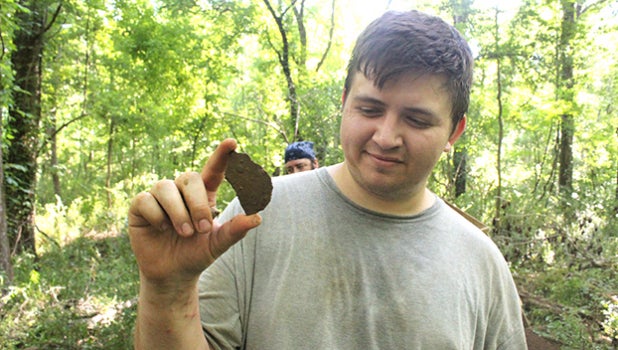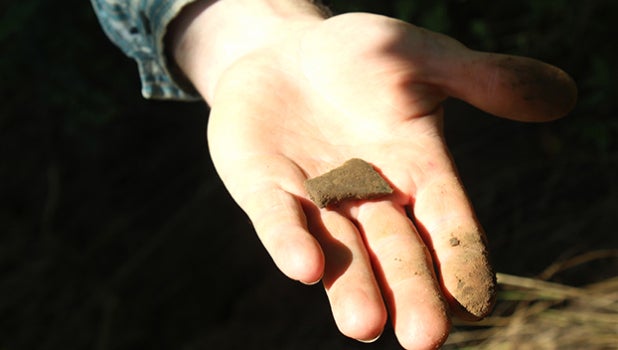Students explore Mississippi archaeological site to answer questions about epicenter of Native American culture
Published 7:45 am Sunday, June 27, 2021
A group of 12 students from the University of Southern Mississippi has excavated the earth while in the shade of Adams County timber for the past three weeks as part of a field study in their archaeology program.
Southern Miss Anthropology Professor Daniel LaDu said the students stay in a house together during the field study. He said he knew they had grown together because they did not go home this past weekend. Instead, they stayed in Natchez to hang out.
Andi Williams, a junior at Southern Miss, said each day of the field study is like summer camp.
“We wake up around six, and we load the car up at 7,” said Williams, who is from Columbus, Georgia. “We are in the car by 7:15, and we are here from 8 to 3:30. It’s like a summer camp but as the job.”
The site of their work is south of Natchez before you get to Sibley.
LaDu said he first visited the site in 2009 to do his master’s thesis. It is a site archaeologists have known about, he said. There are three Indian mounds on the site, and they date back to the late woodland period, which is 1,000 a.d. to 1,100 a.d.
It was built and abandoned in a hundred years by the Coles Creek people, he said. They were a culture and not a tribe, and it is believed the site is the epicenter of the culture. Coles Creek people were known for being hunter-gather groups, he said.
“We decided to come back this year to answer two questions,” LaDu said.
“The first question we wanted to address is how are they using the site. The second question was, is it a village that has folks living here year-round, or are they simply coming here to participate in community rituals.”
The landscape is flat where the students have dug a trench to find features or artifacts. He said the trench is being dug across a plaza. A fence post was discovered in a section of the trench. Students were digging north to see if they could find more posts in a row.
Williams fought roots with her shovel as she excavated the section of soil near the postmark. She said she first wanted to be a marine biologist but discovered it was not her thing. Instead, she gets to work outside, which she enjoys.
On her first day at the site, she was sifting through dirt and found a stone tool the size of her hand. It was the largest artifact she has discovered, she said.
“Finding artifacts is cool. When you are digging. You find something, and you get super excited,” Williams said. “It is like the story is coming together. It’s like a puzzle. It’s the most fun I’ve ever had. It is special when you hold a stone tool, and you think ‘Wow, the last person to touch this is not even here.’”
In the trench, students are documenting the stratigraphy of the soil. LaDu said the top layer is a root layer, the second is disturbed layers where pottery, fire-cracked rock and other objects are found.
Beneath those layers is a buried ground surface. He said it is the zone they are most interested in because there are more artifacts there. Students screen soil for artifacts by moving soil over a shaker.
USM grad student Sarah Coffey of Saraland, Alabama, said they record what they see as they excavate by drawing and taking pictures of the soil makeup.
“Sometimes it is easier to look at the drawing because sometimes things can be difficult to see in a picture. We draw it to scale,” Coffey said. “We also use a soil book. Everyone can look at a portion of soil and say it is five different colors. The book is another way to standardize the recording.”
Natural forces are one challenge the archaeologists have to face at the site. What looks like the sandy side of a cliff near a creek is actually the face of Mound A. It has lost some of its height and size because of the creek’s forces of erosion.
“Half of it is left from what was here when I came out in 2009. We lost even more since I was last out here,” LaDu said. “Erosion causes a loss of context because it displaces the soil positions. Pieces of artifacts then lose value or meaning because they are missing their context.”
Mound A was built in three different construction stages. In the first two stages, the Coles Creek Culture built the mound like a pancake. He said they layered soil on top of the preexisting clay. In the third construction stage, natives stacked different types of soil to produce a collection of vibrant colors. There were also postholes found in the mound, he said.
From Mound A, the terrace extends north. He said it is suspicious because there is a rumored third mound, and they have been unable to identify its location. The group has found a cooking pit on the terrace and other subtle features in addition to Mound A.
Mound B is hidden by vegetation and looks like a foothill from its base. Graduate student Clelie Cottle Peacock of Franklin, Tenn., said the mound was a flat top mound and a location where temples and chieftain houses could be built. Mound A and B more than likely had similar purposes because they are both flat-top mounds.
Mound B is of interest to her. She is interested in learning how to preserve gravesites, and Mound B has a few crypts or false crypts on it. The graves on Mound B and are from the 1800s. Gravesite preservation and artifacts provide a connection to the past, she said.
“We get excited about things most people don’t,” Peacock said. “There was one site I found a brick where you could see a fingerprint in. It gives you such a connection to people and history.”
Mound C is hard to find because it is rumored to be small, LaDu said. It was reportedly a foot high and 20 feet long. Possibly the mound was destroyed at surface level for the planting of crops, he said.
Locating mound C has been a side project for the students. To find the mound, they must first find the footprint. Their search area is about 300 yards north of the plaza area.
USM grad student Jacob Estes of Hattiesburg said a small group of the students are excavating a small portion of the forest floor in the search area. It is where concentrations of artifacts have been found, he said.
He said shovel tests determine if they are in a good spot to dig. He said a high concentration of artifacts is a decent indicator they are in a good place to excavate, and there was.
“This area showed a high density of artifacts around the northern edge, and it also showed elevation along with it,” Estes said. “Mound C was destroyed, so we aren’t going to see it in the forest and say ‘oh there it is.’ We have to find artifacts.”
Estes said he decided to do his thesis at the site because he liked the idea of doing a thesis where he did the excavating.
He said he has learned to tell the difference between a pebble and an artifact in his time working on the project. Southern Miss student Lonnie Burch of Diamondhead, learned a similar lesson in his field study.
“I didn’t know there were so many ways to look at a rock,” Burch said.”
More News






